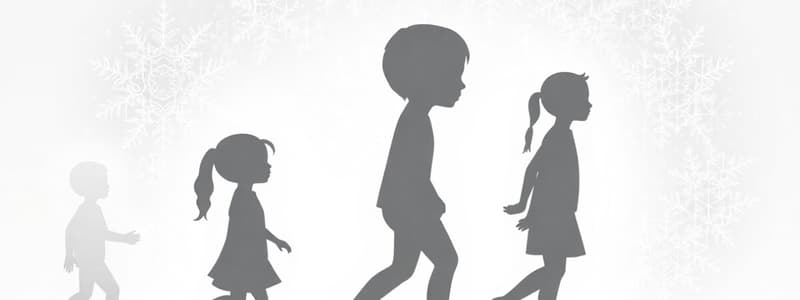Podcast
Questions and Answers
Which of the following is NOT a major period of development according to the provided text?
Which of the following is NOT a major period of development according to the provided text?
- Infancy and Toddlerhood
- Early Adulthood
- Young Adulthood (correct)
- Prenatal Development
What is the key takeaway about lifelong development?
What is the key takeaway about lifelong development?
- Development is a linear progression from birth to death.
- Early research focused on children & modern research focuses on adult development.
- Development only focuses on children and adolescence.
- Development is a continuous process throughout life. (correct)
Which of the following is an example of multidirectional development?
Which of the following is an example of multidirectional development?
- An adult experiencing physical decline due to aging but also emotional maturation. (correct)
- A toddler learning new social skills.
- A child gaining height and weight due to physical growth.
- A teenager developing new cognitive abilities.
What is the importance of the multidisciplinary approach in the study of development?
What is the importance of the multidisciplinary approach in the study of development?
What is the main difference between 'growth' and 'aging' as discussed in the text?
What is the main difference between 'growth' and 'aging' as discussed in the text?
Which of the following is NOT considered a key area of focus in lifespan development?
Which of the following is NOT considered a key area of focus in lifespan development?
What does 'maturation' refer to in the context of multidirectional development?
What does 'maturation' refer to in the context of multidirectional development?
Flashcards
Lifespan Development
Lifespan Development
The study of human growth and changes from conception to death.
Prenatal Development
Prenatal Development
The stage of development from conception to birth.
Early Childhood
Early Childhood
The developmental period from 2 to 6 years old.
Lifelong Development
Lifelong Development
Signup and view all the flashcards
Multidirectional Development
Multidirectional Development
Signup and view all the flashcards
Maturation
Maturation
Signup and view all the flashcards
Multidisciplinary Approach
Multidisciplinary Approach
Signup and view all the flashcards
Multidimensional Development
Multidimensional Development
Signup and view all the flashcards
Adolescence
Adolescence
Signup and view all the flashcards
Middle Adulthood
Middle Adulthood
Signup and view all the flashcards
Study Notes
Lifespan Development
- Definition: The study of human growth and change throughout the whole life, from conception to death.
- Focus Areas: Physical, cognitive, emotional, and social changes.
Major Development Periods
- Prenatal: Conception to birth
- Infancy and Toddlerhood: Birth to 2 years
- Early Childhood: 2 to 6 years
- Middle Childhood: 6 to 11 years
- Adolescence: 12 to 18 years
- Early Adulthood: 18 to 40 years
- Middle Adulthood: 40 to 65 years
- Late Adulthood: 65+ years
Key Features of Human Development
-
Lifelong Development: Human development occurs throughout the entire lifespan, not just during childhood. Early research often focused solely on childhood, but modern theories recognize that development continues throughout life.
-
Multidirectional Development: Development involves both growth and decline at various points in life. Growth and decline can happen simultaneously.
- Growth: Physical changes like increased height and strength seen mainly in children
- Maturation: Physiological development, especially in the brain, and emotional, cognitive and physical improvements
- Aging: Process of getting older, including some physical decline, but also emotional and cognitive improvements and changes are also possible
-
Multidisciplinary Approach: The study of human development combines various fields of study (e.g., psychology, education, medicine, health & social sciences) to create a holistic understanding.
Multidimensional Development
- Development occurs along multiple (interrelated dimensions):
- Biological: changes in the body (growth, aging, brain development)
- Social: changes in relationships, social roles, and interactions (e.g., friendships, family dynamics)
- Emotional: changes in emotional regulation
- Cognitive: changes in thinking, memory, and problem solving
- Moral: development of ethical reasoning, moral values, and behavior
Studying That Suits You
Use AI to generate personalized quizzes and flashcards to suit your learning preferences.




